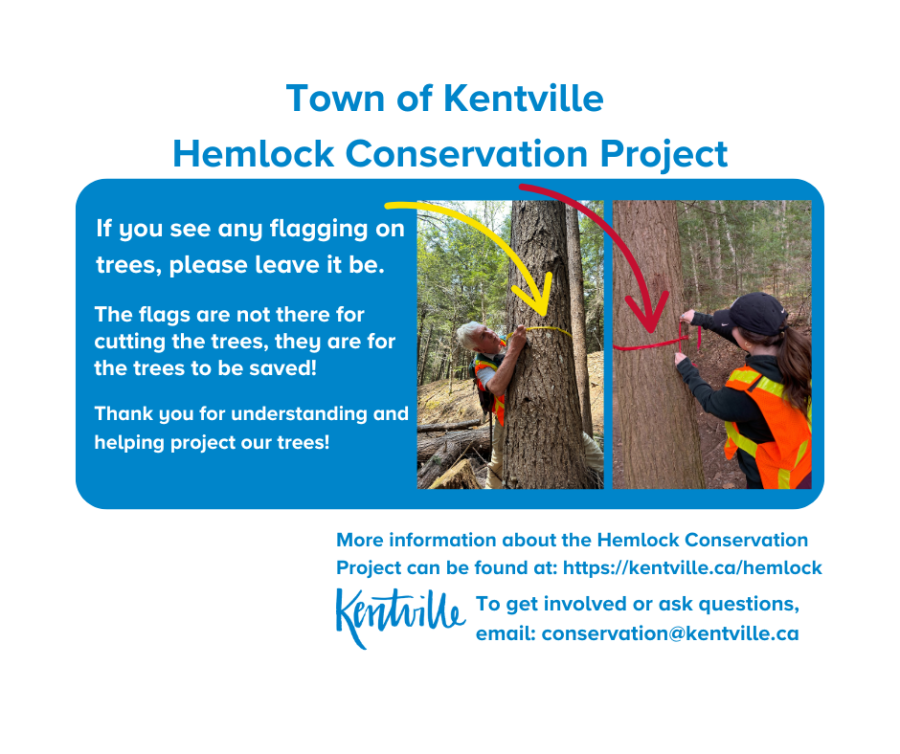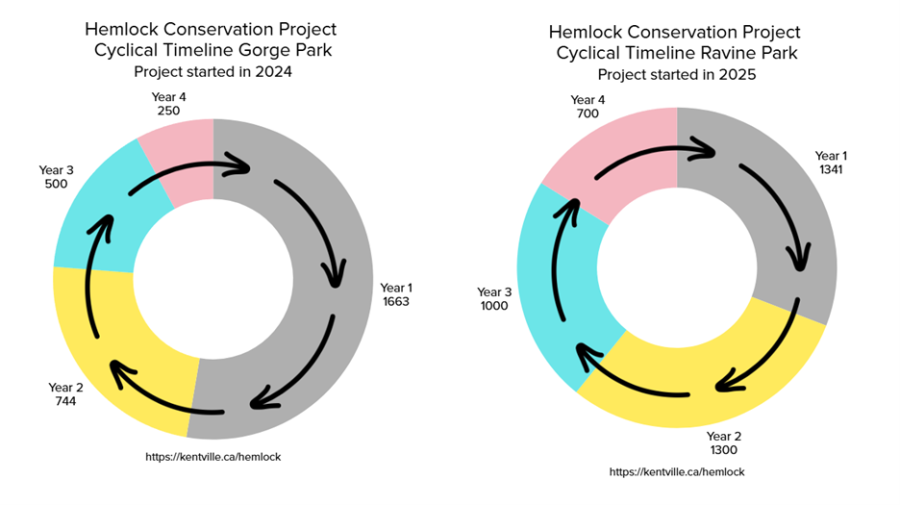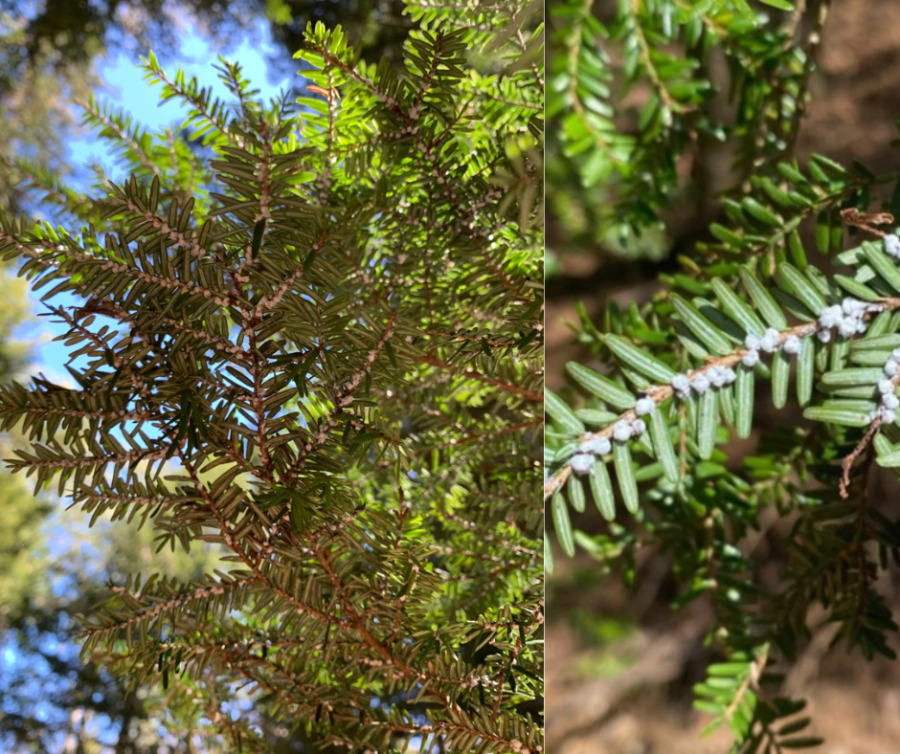
Hemlock Conservation Project
What is the Hemlock Conservation Project?
The Hemlock Woolly Adelgid (HWA) is a harmful insect spreading quickly in Nova Scotia, causing damage to Eastern Hemlock trees. First noticed in Virginia in 1951, it has rapidly moved along the East Coast, devastating hemlock stands. This issue is now affecting southwest Nova Scotia and will soon impact Kings County, particularly in the Gorge and the Ravine Parks, where Eastern Hemlock is abundant.
In the long term (10-50+ years), the goal is to control HWA using natural methods involving predatory insects. However, the immediate concern is to safeguard hemlock stands using available chemical solutions until more sustainable options are viable. The Town of Kentville is collaborating with the Province of Nova Scotia, Medway Community Forest Cooperative, scientists, citizens, and volunteers to address this.
A volunteer network, 'Hemlock Heroes,' has been formed to provide labor, and funding is being sought from various sources. The public's positive response to fundraising efforts underscores the value people place on accessible forests and the opportunities they provide.
Successful examples of protected forest areas in Nova Scotia that serve as models for conservation efforts include Sporting Lake Nature Reserve in Digby County, Kejimkujik National Park, and the United Church Camp in Berwick.
The project begins with a detailed inventory of hemlock trees in the Gorge, measuring trunk diameter and tagging them. Treatment, supervised by qualified personnel from Medway Community Forest Cooperative, Acadia University, and non-governmental organizations, involves using approved pesticides (IMA-jetÒ. and Xytect 2FÒ). Trees near water receive trunk injections, while others get a basal trunk spray. This approach has proven effective elsewhere in Nova Scotia and will be repeated in other possible safe areas over the next few years. The pesticides used are imidacloprid and are approved for this purpose in Canada.
Project Timeline - 4 Year Cycle:
The Kentville Hemlock Conservation Project operates on a 4-year cycle. Trees tagged and treated in year 1, will receive treatment again 4 years later. The same trend follows for subsequent years 2, 3, and 4. This 4-year cycle causes the number of total trees treated to fluctuate per year, as visualized in the graphs below.
The graphs above show the Hemlock Conservation Project 4-year Cycle for both the Gorge and the Ravine parks. Every 4 years, the cycle starts over, and trees will be retreated with pesticide to provide resilience against HWA. The graphs show the fluctuation of the total number of trees treated each year.
2025 Summer Season Update
In spring/summer of 2025, the following number of trees were tagged and treated against HWA in our parks.
Ravine: 1,005 trees
Gorge: 742 trees
Throughout the fall 2025, the Town of Kentville staff will continue with micro-injections of pesticide into 342 more trees.
TOTAL NUMBER OF KENTVILLE TREES PROTECTED AGAINST HWA (ACROSS ALL YEARS): 3,255 trees
What is Hemlock Woolly Adelgid?
Hemlock Woolly Adelgid (Adelges tsugae) or ‘HWA’ is a tiny invasive insect. It attacks and kills eastern hemlock trees by feeding on the water and nutrient storage cells at the base of the needles. The insect, itself, is almost too small to see (pepper flake-sized), but white, woolly growth secreted by each female as she grows makes her become more visible through late winter-spring.
HWA can kill hemlock in 3-10 years. Areas of Nova Scotia where winters are mildest appear to experience more rapid mortality. HWA feeds for most of the winter underneath the branch tips on the newest growth. The insects are all female, each capable of laying fertile eggs. HWA produces two generations each year.
Once a hemlock stand becomes infested, the race ensues to conserve trees before the canopy drops its needles and becomes too thin to treat.
Source: Medway Community Forest Cooperative
What is the potential for hemlock woolly adelgid to spread?
Once established, HWA will spread naturally via wind, birds, animals, and human movement of nursery stock, logs, and other wood products, including firewood. To help prevent the spread of this pest the public is encouraged not to move potentially infested firewood and other hemlock forest products.
Source: Government of Canada
Why is this initiative important?
This initiative is crucial for several reasons:
-
Maintaining Biodiversity: The project aims to preserve 'pocket stands' or refugia, creating safe areas for the regeneration and recovery of the Eastern Hemlock trees. This helps maintain biodiversity by safeguarding the natural balance of the ecosystem.
-
Climate Change Resilience: Protecting the forest in the Gorge contributes to climate change resiliency. The living trees act as a natural defense against fire, especially important in a residential and commercial area. This proactive measure helps in adapting to the changing climate.
-
Preserving Habitat for Species-at-Risk: By preventing the loss of Eastern Hemlock, the initiative safeguards the habitat for various species. There are no identified threats to known species-at-risk in the Gorge from the treatment, highlighting the importance of protecting the hemlock trees to maintain the overall health of the ecosystem.
-
Community and Environmental Impact: The project's location in a residential and commercial area emphasizes its importance for the community. Preserving the Gorge not only contributes to the town's aesthetics but also maintains the recreational and environmental value of the area.
-
Sustainable Forest Management: By implementing a supervised program of pesticide application, the initiative demonstrates a commitment to sustainable forest management. Balancing immediate needs with long-term goals ensures the health and longevity of the forest ecosystem.
In summary, this initiative is vital for preserving local biodiversity, enhancing climate change resilience, protecting habitat for species-at-risk, and ensuring the well-being of the community and environment in the Gorge.
What you can do?
There are several things an individual can do to help stop the spread of HWA and protect our Eastern Hemlocks.
-
Do research to educate yourself on the issue. You’re off to a great start! Next, educate your friends, family, and community to help raise awareness of HWA and the threat it causes to Eastern Hemlocks.
-
Help avoid the rapid spread of HWA by following these tips:
-
Avoid placing bird feeders near Hemlock trees. Birds can transport HWA to new areas.
-
Don’t move firewood [C1]. Buy local, burn local. Human movement of wood increases the spread of HWA.
-
Use a lint roller to remove invasive species from your clothing after being in the woods. This avoids spreading HWA yourself.
-
-
Get involved! Volunteer with the Town of Kentville to work on our Hemlock Conservation Project. Volunteer sign-up sheet can be found here.
In summary, this initiative is vital for preserving local biodiversity, enhancing climate change resilience, protecting habitat for species-at-risk, and ensuring the well-being of the community and environment in the Gorge.
A special thanks to our partners:
Blomidon Naturalists Society
Rotary Club of Wolfville- Mud Creek
Rotary Clubs of Kings County Charitable Foundation
Medway Community Forest Cooperative
Nova Scotia Invasive Species Council
Community-led Hemlock Conversation Advisory Committee



